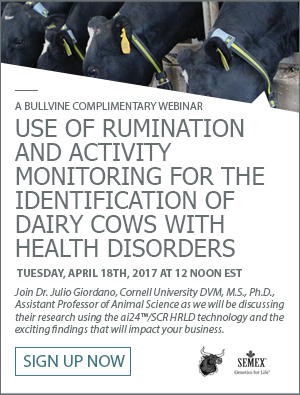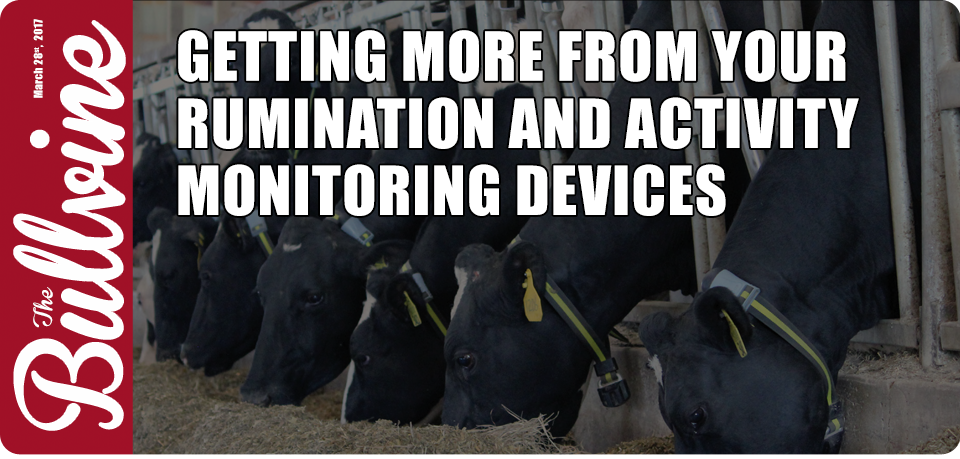Have you ever bought a new piece of equipment only to get less than 50% of what the sales person ‘promised’ it would provide? It is both sad and negative for agriculture when farmers get oversold on new technology. But, let’s be positive! Have you ever invested in new technology and got more than your money’s worth? The Bullvine recently read about such a situation. It came to our attention via a series of scientific reports in the Journal of Dairy Science (JDS Vol. 99 No. 9, 2016) where a study was done at Cornell University, Ithaca, New York about the use of automated health-monitoring system (AHMS).
Study Hypothesis
By knowing the details from an automated health-monitoring system (AHMS), the researchers wanted to determine if, beyond heats (activity) and rumen health (rumination), predictions could be made on the presence of metabolic and digestive disorders including displaced abomasum, ketosis, indigestion, mastitis, and metritis.
Cornell Study
Researchers decided that one more research farm study was not what dairy farmers needed or wanted to hear about. So, they found a 1100 cow free stall commercial dairy where management and experienced workers were willing to take the time and effort to record digestive and health disorders. Farm workers were present 24 hours per day and went about their work without knowing what data the AHMS was capturing. This provided for the researches to have unbiased, independent data from two sources to use in their analysis. Cows were fitted with a neck-mounted electronic rumination and activity monitoring tag and rumination time and physical activity information was recorded from 21 days before expected calving until at least 80 days after calving. The study covered a year-long period with recording of performance in the parlor of this 3x herd. The herd’s 305-day performance was 13,036 kgs. (28,725 lbs), and it’s TMR diets were standards for New York State. Pre-calving heifers and cows were housed separately. For a month after calving all cows were housed together and from then on cows were grouped by lactation number.
Study Synopsis
The rumination and activity details were continually captured and uploaded to the central processor every two hours. The digestive and health disorder data, both observed and suspected, came from the workers’ recordings. The information from both sources was used to develop a dynamic ‘health index score’ (HIS). Researchers created alert levels for the HIS when metabolic and/or digestive problems might be suspected. The researchers then tested these HIS alert levels against the herd’s people making a clinical diagnosis of one of the five disorders. Exact protocols were followed, and disorder descriptions were clearly defined. Blood was drawn, and testing was done on groups of animals in order to augment and verify the clinical diagnosis, as determined by the herd’s people.
End Objective
The end objective, from using the HIS, was to be able to predict, using activity and rumination data, a problem before it would have been clinically diagnosed. Knowing one day ahead is a start but knowing the possibility of a problem up to 3-5 days ahead has the potential to be a game-changer for managing to avoid metabolic and digestive disorders.
Health Disorder Incidence
A review of the scientific literature shows the following incidences of and facts about metabolic and digestive disorders:
- Disease frequency (% of all disorders): Mastitis 35-45%; Metritis 12-15%; Retained Placenta 7-10%; Displaced Abomasum 4-6% and Ketosis 3-5%.
- The majority of health and digestive diseases occur in the first month of lactation
- The frequency of mastitis and high SCC increases with cow age
- Milk Fever (4-5%), not included in this study, rarely occurs in first lactation and incidence is variable between herds.
Definitely, the disorders in this Cornell study are prevalent enough (70% of all disorders) that any avoidance of them could significantly impact the bottom line of farms.
Study Results
The key findings from the study are the rate of detection of a disorder and the days in advance that the HIS would have detected a possible disorder as compared to the farm staff making a clinical diagnosis. An interesting fact for this herd was that 58% of the cows had at least one of the five disorders and 42% had none. 70% of cows with a disorder had one, and 30% had more than one disorder.
Table 1 Study Disorders – Incidence, Occurance, Prediction Accuracy and Prediction before Diagnosis
Mastitis and metritis events occurred in 44% of the cows. However, the accuracy of prediction for these two was the lowest of the disorders. The half day ahead of clinical diagnosis for mastitis, lower that for three of the other disorders, is not surprising considering this was a well-managed herd, milked 3x daily. Interesting to note was that for E Coli mastitis the accuracy of prediction was 81%, much higher than for overall mastitis at 58%. All disorders, except for mastitis, occurred very early in lactation. The results are very encouraging for the detection of the metabolic disorders, considering that they are much harder for herds people to detect than mastitis or sub-clinical metritis.
Is It Worth Knowing?
The short answer on whether or not to use the AHMS to monitor for metabolic and digestive disorders is yes.
Greater ROI
Without doing a full simulation on extending the use made of an AHMS to included monitoring for health disorders has yet to be documented on a financial basis. Some facts that every herd manager knows to be true include:
- Having a single health disorder can cost from $250 – $500 per incidence in treatment costs and lost income, all the way to early culling and even the death on-farm of the animal
- Saleable milk is lost during the disorder, and the total lactation yield is decreased
- Drugs are costly, and the drug bill can mount up depending on the disorder, and
- It takes extra labor to care for sick animals.
However, those are only the start of the ways in which having your AHMS predict a disorder can pay back dividends. Here are points to include when considering the ROI of an AHMS:
- The AHMS works 24 hours every day, takes no holidays and requires no weekly wage.
- The AHMS can, at least partially, eliminate the need for staff to be continually monitoring dry, fresh and breeding pens. It could likely decrease the size of the workforce, or it could permit staff to put more effort into another area of the farming enterprise.
- Experienced herds persons know that early detection of any abnormal condition can be a major advantage when it comes to minimizing severity or in increased speed of recovery.
- As well as providing herd manager with information to catch heats and improve pregnancy rates, catching even 50% of the metabolic and digestive disorders before they get serious can add $200+ per cow per year to net yearly profit for the entire herd. That’s significant!
- For information purposes, it should be noted that an AHMS cost is from $ $150-$175 USD per animal (collars + data system).
The Bullvine Bottom Line
This study shows that the information from an AHMS can reliably be used to predict metabolic and digestive disorders before they occur. More information to enhance a herd’s management level and the bottom line is something progressive managers are always on the lookout for. Herd managers can thereby use all the tools, intuition, observation and data, to take their herd to higher profit.

Leading producers are always looking for ways to better monitor their animals. The focus on developing solid SOPs for identifying sick cows has also resulted in increased lock up times. What would be the value of knowing a cow was sick 1-2 days before you can see it? Dairies now can have precision animal monitoring that can integrate their SOP’s and provide imitate results for both health and reproduction.
Join Dr. Julio Giordano, Cornell University DVM, M.S., Ph.D., Assistant Professor of Animal Science on Tuesday, April 18th, 2017 at 12 noon EST as we will be discussing their research using the ai24™/SCR HRLD technology and the exciting findings that will impact your business.
Click here to sign up for this free webinar.

















Leave a Reply
You must be logged in to post a comment.